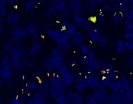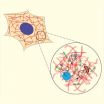(Press-News.org) VIDEO:
Scientists studied how just a few nerve cell in the mouse brain may control the switch between internal thoughts and external distractions. Using optogenetics, a technique that uses light-sensitive molecules...
Click here for more information.
Ever wonder why it's hard to focus after a bad night's sleep? Using mice and flashes of light, scientists show that just a few nerve cells in the brain may control the switch between internal thoughts and external distractions. The study, partly funded by the National Institutes of Health, may be a breakthrough in understanding how a critical part of the brain, called the thalamic reticular nucleus (TRN), influences consciousness.
"Now we may have a handle on how this tiny part of the brain exerts tremendous control over our thoughts and perceptions," said Michael Halassa, M.D., Ph.D., assistant professor at New York University's Langone Medical Center and a lead investigator of the study. "These results may be a gateway into understanding the circuitry that underlies neuropsychiatric disorders."
The TRN is a thin layer of nerve cells on the surface of the thalamus, a center located deep inside the brain that relays information from the body to the cerebral cortex. The cortex is the outer, multi-folded layer of the brain that controls numerous functions, including one's thoughts, movements, language, emotions, memories, and visual perceptions. TRN cells are thought to act as switchboard operators that control the flow of information relayed from the thalamus to the cortex.
To understand how the switches may work, Dr. Halassa and his colleagues studied the firing patterns of TRN cells in mice during sleep and arousal, two states with very different information processing needs. The results published in Cell, suggest that the TRN has many switchboard operators, each dedicated to controlling specific lines of communication. Using this information, the researchers could alter the attention span of mice.
"The future of brain research is in studying circuits that are critical for brain health and these results may take us a step further," said James Gnadt, Ph.D., program director at NIH's National Institute Neurological Disorders and Stroke (NINDS), which helped fund the study. "Understanding brain circuits at the level of detail attained in this study is a goal of the President's Brain Research through Advancing Innovative Neurotechnologies (BRAIN) Initiative."
To study the circuits, the researchers identified TRN cells that send inhibitory signals to parts of the thalamus known to relay visual information to the cortex. Using a technique known as multi-electrode recordings, they showed that sleep and concentration affected these cells in opposite ways.
They fired often when the mice were asleep, especially during short bursts of simultaneous brain cell activity called sleep spindles. These activity bursts briefly widen electrical brain wave traces making them look like spindles, the straight spikes with rounded bottoms used to make yarn. In contrast, the cells fired infrequently when the mice were tasked with using visual cues to find food. The results suggested that these cells blocked visual information from reaching the cortex during sleep and allowed its transmission when the mice were awake and attentive.
For Dr. Halassa, a practicing psychiatrist who treats schizophrenia, these surprising results may provide fundamental insights into how the brain controls information transmission, a process that is disrupted in patients with neuropsychiatric disorders. Previous studies suggested that people who experienced more spindles while sleeping were less susceptible to being disturbed by outside noises. Moreover, people with schizophrenia and autism spectrum disorder may experience fewer spindles.
"Spindles may be peepholes into the mysteries of these disorders," said Dr. Halassa.
To test this idea, the researchers used optogenetics, a technique that introduces light-sensitive molecules into nerve cells. This allowed them to precisely control the firing patterns of visual TRN cells with flashes of laser light. The experiments were performed in well-rested as well as sleep-deprived mice. Similar to what is seen in humans, sleep deprivation can disrupt the ability of mice to focus and block out external distractions.
Well-rested mice needed just a second or two to find the food whereas sleep-deprived mice took longer, suggesting that lack of sleep had detrimental effects on their ability to focus. When the researchers used flashes of laser light to inhibit the firing of optogenetically engineered visual TRN cells in sleep-deprived mice, the mice found the food faster. In contrast, if they used optogenetics to induce sleep-like firing patterns in well-rested mice, then the mice took longer to find food.
"It's as if with a flick of a switch we could alter the mental states of the mice and either mimic or cure their drowsiness," said Dr. Halassa.
In a parallel set of experiments the researchers found neighbors of the visual TRN cells had very different characteristics. These neighboring cells control the flow of information to the cortex from limbic brain regions, which are involved with memory formation, emotions and arousal. The cells fired very little during sleep and instead were active when the mice were awake. Dr. Halassa thinks that their firing pattern may be important for the strengthening of new memories that often occurs during sleep. Combined, the results suggest that the TRN is divided into sub-networks that oversee discrete mental states. The researchers think understanding the sub-networks is an initial step in thoroughly exploring the role of the TRN in brain disorders.
INFORMATION:
This work was supported by grants from the NINDS (NS078115, NS077986), the National Institute of Mental Health (MH101209, MH057414, MH103908, MH061976), the National Institute of General Medicine (GM104948), National Science Foundation (IIS-1307645, SBE-0354378), and the Mathematical Biosciences Institute.
References
Halassa et al. "State-dependent architecture of thalamic reticular sub-networks," Cell, August 14, 2014. DOI: 10.1016/j.cell.2014.06.025
For more information on sleeping and other neurological disorders:
http://www.ninds.nih.gov/disorders/disorder_index.htm
The BRAIN Initiative is a bold new research effort to revolutionize our understanding of the human mind and uncover new ways to treat, prevent, and cure brain disorders like Alzheimer's, schizophrenia, autism, epilepsy, and traumatic brain injury. For more information:
http://www.nih.gov/science/brain/
NINDS is the nation's leading funder of research on the brain and nervous system. The mission of NINDS is to seek fundamental knowledge about the brain and nervous system and to use that knowledge to reduce the burden of neurological disease.
About the National Institutes of Health (NIH): NIH, the nation's medical research agency, includes 27 Institutes and Centers and is a component of the U.S. Department of Health and Human Services. NIH is the primary federal agency conducting and supporting basic, clinical, and translational medical research, and is investigating the causes, treatments, and cures for both common and rare diseases. For more information about NIH and its programs, visit http://www.nih.gov.
Scientists use lasers to control mouse brain switchboard
NIH-funded study explores how information flow in the brain is centrally regulated for sleep and wakefulness
2014-08-14
ELSE PRESS RELEASES FROM THIS DATE:
Long antibiotic treatments: Slowly growing bacteria to blame
2014-08-14
Whether pneumonia or sepsis – infectious diseases are becoming increasingly difficult to treat. One reason for this is the growing antibiotic resistance. But even non-resistant bacteria can survive antibiotics for some time, and that's why treatments need to be continued for several days or weeks. Scientists at the Biozentrum of the University of Basel showed that bacteria with vastly different antibiotic sensitivity coexist within the same tissue. In the scientific journal Cell they report that, in particular, slowly growing pathogens hamper treatment.
Many bacteria ...
Tissue development 'roadmap' created to guide stem cell medicine
2014-08-14
In a boon to stem cell research and regenerative medicine, scientists at Boston Children's Hospital, the Wyss Institute for Biologically Inspired Engineering at Harvard University and Boston University have created a computer algorithm called CellNet as a "roadmap" for cell and tissue engineering, to ensure that cells engineered in the lab have the same favorable properties as cells in our own bodies. CellNet and its application to stem cell engineering are described in two back-to-back papers in the August 14 issue of the journal Cell.
Scientists around the world are ...
Antibodies, together with viral 'inducers,' found to control HIV in mice
2014-08-14
Although HIV can now be effectively suppressed using anti-retroviral drugs, it still comes surging back the moment the flow of drugs is stopped. Latent reservoirs of HIV-infected cells, invisible to the body's immune system and unreachable by pharmaceuticals, ensure that the infection will rebound after therapy is terminated.
But a new strategy devised by researchers at Rockefeller University harnesses the power of broadly neutralizing antibodies against HIV, along with a combination of compounds that induce viral transcription, in order to attack these latent reservoirs ...
Researchers identify a mechanism that stops progression of abnormal cells into cancer
2014-08-14
(Boston)-- Researchers from Boston University School of Medicine (BUSM) report that a tumor suppressor pathway, called the Hippo pathway, is responsible for sensing abnormal chromosome numbers in cells and triggering cell cycle arrest, thus preventing progression into cancer.
Although the link between abnormal cells and tumor suppressor pathways—like that mediated by the well known p53 gene—has been firmly established, the critical steps in between are not well understood. According to the authors, whose work appears in Cell, this work completes at least one of the ...
Researchers develop strategy to combat genetic ALS, FTD
2014-08-14
JACKSONVILLE, Fla. — A team of researchers at Mayo Clinic and The Scripps Research Institute in Florida have developed a new therapeutic strategy to combat the most common genetic risk factor for the neurodegenerative disorders amyotrophic lateral sclerosis (ALS or Lou Gehrig's disease) and frontotemporal dementia (FTD). In the Aug. 14 issue of Neuron, they also report discovery of a potential biomarker to track disease progression and the efficacy of therapies.
The scientists developed a small-molecule drug compound to prevent abnormal cellular processes caused by a ...
Inside the cell, an ocean of buffeting waves
2014-08-14
Cambridge, Mass. – August 14, 2014 – Conventional wisdom holds that the cytoplasm of mammalian cells is a viscous fluid, with organelles and proteins suspended within it, jiggling against one another and drifting at random. However, a new biophysical study led by researchers at Harvard University challenges this model and reveals that those drifting objects are subject to a very different type of environment.
The cytoplasm is actually an elastic gel, it turns out, so it puts up some resistance to simple diffusion. But energetic processes elsewhere in the cell—in the cytoskeleton, ...
Forcing chromosomes into loops may switch off sickle cell disease
2014-08-14
Scientists have altered key biological events in red blood cells, causing the cells to produce a form of hemoglobin normally absent after the newborn period. Because this hemoglobin is not affected by the inherited gene mutation that causes sickle cell disease, the cell culture findings may give rise to a new therapy for the debilitating blood disorder.
The novel approach uses protein-engineering techniques to force chromatin fiber, the substance of chromosomes, into looped structures that contact DNA at specific sites to preferentially activate genes that regulate hemoglobin. ...
NASA sees Tropical Storm Julio now far from Hawaii
2014-08-14
Hurricane Julio moved past the Hawaiian Islands like a car on a highway in the distance, and NASA's Terra satellite captured an image of the storm, now downgraded to a tropical storm located more than 700 miles away. Julio is far enough away from Hawaii so that there are no coastal watches or warnings in effect.
On August 13 at 21:10 UTC (5:10 p.m. EDT), the Moderate Resolution Imaging Spectroradiometer of MODIS instrument aboard NASA's Terra satellite captured a visible image of Hurricane Julio moving through the Central Pacific Ocean. The visible image shows that powerful ...
EARTH Magazine: Are slow-slip earthquakes under Tokyo stressing faults?
2014-08-14
Alexandria, Va. — Tokyo, a city of more than 13 million people, has been devastated by earthquakes in the past and likely will be again. But when? And what role do ongoing slow-slip earthquakes — the kind that generally can't be felt at the surface — play in relieving or building up stress?
New research examining plate movements under Tokyo has found that since the massive magnitude-9 Tohoku earthquake and tsunami in March 2011, recurrence intervals for nondamaging slow-slip quakes beneath Japan's capital have shortened. That has left seismologists wondering if this aseismic ...
A husband's declining health could put Taiwanese women at risk for health issues
2014-08-14
PRINCETON, N.J.—The death of a spouse undoubtedly brings with it stress, anxiety and uncertainty. Now, a report by Princeton University's Woodrow Wilson School of Public and International Affairs quantifies this stress, showing how a husband's declining health could put Taiwanese women at risk for health issues.
Using data from a longitudinal sample of Taiwanese older adults, the researchers found that the more a husband suffered, the more his wife's glucose levels increased. Yet, when a wife's health was declining, her husband's levels remained the same. Being widowed, ...
LAST 30 PRESS RELEASES:
Numbers in our sights affect how we perceive space
SIMJ announces global collaborative book project in commemoration of its 75th anniversary
Air pollution exposure and birth weight
Obstructive sleep apnea risk and mental health conditions among older adults
How talking slows eye movements behind the wheel
The Ceramic Society of Japan’s Oxoate Ceramics Research Association launches new international book project
Heart-brain connection: international study reveals the role of the vagus nerve in keeping the heart young
Researchers identify Rb1 as a predictive biomarker for a new therapeutic strategy in some breast cancers
Survey reveals ethical gaps slowing AI adoption in pediatric surgery
Stimulant ADHD medications work differently than thought
AI overestimates how smart people are, according to HSE economists
HSE researchers create genome-wide map of quadruplexes
Scientists boost cell "powerhouses" to burn more calories
Automatic label checking: The missing step in making reliable medical AI
Low daily alcohol intake linked to 50% heightened mouth cancer risk in India
American Meteorological Society announces Rick Spinrad as 2026 President-Elect
Biomass-based carbon capture spotlighted in newly released global climate webinar recording
Illuminating invisible nano pollutants: advanced bioimaging tracks the full journey of emerging nanoscale contaminants in living systems
How does age affect recovery from spinal cord injury?
Novel AI tool offers prognosis for patients with head and neck cancer
Fathers’ microplastic exposure tied to their children’s metabolic problems
Research validates laboratory model for studying high-grade serous ovarian cancer
SIR 2026 delivers transformative breakthroughs in minimally invasive medicine to improve patient care
Stem Cell Reports most downloaded papers of 2025 highlight the breadth and impact of stem cell research
Oxford-led study estimates NHS spends around 3% of its primary and secondary care budget on the health impacts of heat and cold in England
A researcher’s long quest leads to a smart composite breakthrough
Urban wild bees act as “microbial sensors” of city health.
New study finds where you live affects recovery after a hip fracture
Forecasting the impact of fully automated vehicle adoption on US road traffic injuries
Alcohol-related hospitalizations from 2016 to 2022
[Press-News.org] Scientists use lasers to control mouse brain switchboardNIH-funded study explores how information flow in the brain is centrally regulated for sleep and wakefulness





